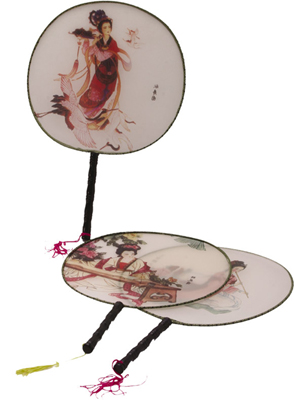
Chinese fans were used in daily life and have a long history in China.
The first fans were made of birds' feathers and tree leaves. It was
recorded that a fan made of pheasants' feathers was made in the Shang
Dynasty.
The Chinese hand-held fan comes in various styles and is made with
different materials, including bamboo, paper, bone, feather, ivory, carved
lacquerware and paper or silk. Fans made of palm tree leaves are both economical
and practical and are very popular among the people. And the most precious fans
are those made of mother-of-pearls. The oldest Chinese hand-held fan which dates
back to about 2,300 years ago in the Warring States Period was uncovered in
Hubei province in 1982.
Among the various types of Chinese hand-held
fans, only two are sort after as collector's items, namely the Tuan Shan (a
reunion fan or round fan) and the Zhe Shan (a plaited fan that can be folded).
Although in theory Tuan Shan refers to all round-shaped fans,
conventionally to the Chinese, Tuan Shan specifically refers to those fans made
of silk materials, which are mainly round- or oval-shaped. In addition,
square-shaped and rectangular fans with rounded corners are also called Tuan
Shan.
Zhe Shan was already used in China during the Song dynasty (960-1279) but it was not until the Ming dynasty (1368-1644) that it became a trendy item. During the Ming era, Zhe Shan production houses sprang up in all parts of China, and the techniques of the Chinese Zhe Shan maker gained refinement. The popularity of Zhe Shan came to its peak in the Qing era (1644-1911) where it became an artistic item that symbolises a special social status, and was commonly carried by the government officials. During those times, Zhe Shan was not only used as a tool to keep cool in the summer period. The Chinese also used it in the cooler seasons to express their characteristics and moods, or just to make a fashion statement.